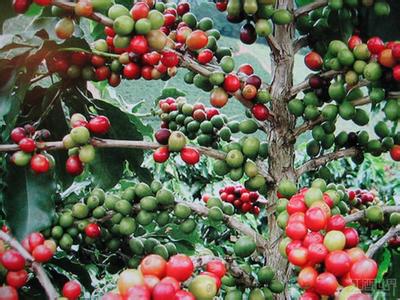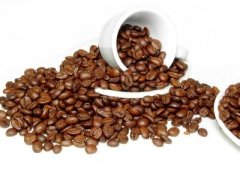Detailed introduction of 11 coffee bean producing countries

1. Jamaica (Jamaica) mentioned Jamaica, and we immediately heard of "Blue Mountain" coffee. Rare and expensive blue mountain beans, originally from the Wallensford Coffee Garden, have now expanded to the Blue Mountains, which are more than 1,000 meters above sea level. as long as the tree species and treatment procedures of the estate meet certain standards, the government will issue a guarantee to allow the use of the name "Blue Mountain". It used to be the protagonist of coffee mythology, but many people think that the legendary characteristics-rich aroma, complete texture, perfect combination with even and palatable sour taste-are no longer there, and the beautiful sour taste that existed 15 years ago can only be found in memories. In spite of this, its price still goes up. In Taiwan, the retail price of guaranteed raw beans is usually more than 2000 yuan per kilogram. In the market for raw beans, which are commonly packed in gunny bags, blue mountain beans that insist on barrel packaging show their extraordinary price. The term "Jamaica High Mountain" refers to coffee beans grown in other mountains less than 1,000 meters on the island, which are of relatively ordinary quality and have a mild texture and sour taste. As for "Blue Mountain Blend" or "Blue Mountain Style" coffee, it is usually a combination of good Colombian beans, intended to imitate the taste of Blue Mountain, and has nothing to do with Jamaica. You won't find any real blue beans in Blue Mountain coffee.
two。 Beans from the Dominican Republic of the Dominican Republic (Dominican Republic) are often called "Santo Domingan" (their old country name), where coffee plantations are mainly surrounded by mountains in the middle of the island. There are four kinds of washed alpine coffee on the market: Cibao, Bani, Ocoa and Barahona. The latter three are especially praised. The sweet taste of soft ripe fruit is very similar to that of Haitian coffee, while Balahona has a high acidity and a thick taste of typical Caribbean beans, which is close to the Jamaican mountains in quality and characteristics. Baking to medium depth best highlights their sweetness.
3. Cuba (Cuba) cigars, coffee and sugar cane, as the three major industries of the Republic of Cuba, enjoy a high reputation in the world. Cuban Crystal Mountain Coffee ranks among the top in the world. Crystal Mountain is adjacent to Jamaica's Blue Mountain Mountains and has similar climatic conditions, which is comparable to Jamaica's Blue Mountain Coffee. Similarly, the annual output of imported coffee from Crystal Mountain in Cuba is not high, so most of the time there is no market. The most representative is the "Cubita Coffee" of the three major coffee in Cuba, which is known as the coffee with unique Caribbean flavor and has become the designated coffee of the Cuban embassy.
4. Puerto Rico (Puerto Rico) beans, named after the special Yauco Selecto, are the best example of Caribbean beans, with a rich texture, balanced taste, gentle but complex depth. Deep-baked Caribbean beans do not have the rough burning taste common in other deep-baked beans and are suitable for filter kettles (Plunger or French Press) and other cooking methods that have been soaked for a long time.
5. The word Mocha in Yemen has many meanings. Around 600 AD, the first coffee bean far from its hometown, Ethiopia, took root in the leaf gate on the other side of the Red Sea and started the coffee industry all over the world. Since the most important export port of Yemeni coffee in the early days was the port of Mocha (now silted up), the coffee produced in Yemen was also called "mocha" beans. Over time, some people began to use "mocha" as a nickname for coffee. The situation is similar to that in Java today. Later, because the aftertaste of mocha coffee resembled chocolate, the word "mocha" was extended to be a mixture of hot chocolate and coffee. Therefore, the same is "mocha", mocha beans, mocha pot and Italian coffee in mocha coffee, but represent three meanings. Today's Yemeni mocha (Yemen Mocha) is no different from its ancestors more than a thousand years ago, and is the most advanced traditional hand-dried bean-although it varies in size and contains a lot of impurities. The two most common producing areas are Mattari and Sanani; Matali beans have more texture, chocolate and sour taste, while Shanani beans are more balanced and fragrant. Generally speaking, the average size of mocha beans is small, with the wild and spicy smell of ginger, bright and unique taste, pleasant fruit acidity, and rich wine-like texture, no wonder it is known as the Bordeaux wine in coffee. In mixed coffee, mocha usually plays the role of high-pitched voice, responsible for stimulating and improving flavor.
6. Ethiopia (Ethiopia) the highlands of Ethiopia are the birthplace of coffee. The traditional drying method is still used to produce mocha-Hara beans (Harrar,Harari,Harer or Harar) at an altitude of about 2,000 meters near Harrar in the east. Hara has a medium texture with a fruit wine-like flavor, and a good Hara is as wild as the best Yemenmoka. Dried beans from other regions, such as Gimbi or Ghimbi, Jima,Jimma or Djimah and Sidamo, are equally wild and wine-like, but not so rich and a little rough. The water-washed mocha from Jinbi in the west has the same sour wine as Hara, but it is packaged with a richer and balanced feel and a thicker texture. As for water-washed beans from the south, such as Sidamo and Gemma, they keep less sour wine and replace them with more gentle and delicate flavours of lemon and flowers. The best is produced in a high, narrow area of Sidamone, called Yirgacheffe, whose rich taste brushes the taste buds and leaves an endless aftertaste, while the slightly sour taste is similar to Sumatra, swimming in a rich texture; in addition, it adds a unique soft floral fragrance, which is really the only coffee in the world.
7. Most of the Tanzanian beans in Tanzania grow in Mr. Kilimanjaro and Mt, near the northern Kenyan border. The Meru area, often called "Clemangaro", is occasionally named after the distribution center Moshi or Arusha. In addition, on the southern side of the border, a little washed Arabica beans are produced, named after the nearby big city Mbeya or the distribution center Pare. The way of grading is similar to that of Kenya, distinguishing sizes by the English alphabet. Most Tanzanian beans have typical African bean characteristics. The better Clemencaro, similar to ordinary Kenya, has a strong texture, is usually milder acidic than Kenya, and evenly stimulates the taste buds in the middle and sides of the back of the tongue. It tastes a bit like tomato or soda. As for southern beans, they are similar to secondary water-washed mochas, with soft and ingratiating weak acidity, round taste, and medium texture. Beans from neighboring Malawi also have the same quality as Tanzanian beans.
8. Uganda (Uganda) produces a pretty good Arabica bean, called Bugisu or Bugishu, on the western slope of the Egon Mountains (Mr. Elgon) near the Kenyan border in the east. The flavor is similar to Kenya, but the texture is thinner.
9. Zimbabwe is also a typical East African bean with a medium texture, but its strong acidity and fruit wine can be compared with Kenya, with a hint of black pepper. The finest Zimbabwe beans are produced in the eastern part of the country near Mozambique. Classified by size, "053" is the most advanced.
10. The coffee beans produced in the high latitudes of Costa Rica are famous in the world, full-bodied, mild in taste, but extremely sour. The coffee beans here have been carefully processed, which is why they have high quality coffee. The famous coffee is produced in the Central Plateau (Central Plateau), where the soil consists of successive layers of volcanic ash and dust. According to the Kenyan Standard, global coffee prices continue to rise as major buyers continue to seek higher quality coffee, while coffee producers Uganda, Rwanda and Ethiopia are in harvest season. Industry insiders say East African countries are higher above sea level, coffee plantations are usually operated on a small scale, and African growers are better able to take care of coffee trees than large-scale plantations such as Brazil.
11. Kenya Coffee is produced near the Kenyan Mountains in the middle of the country, sometimes with the name Nairobi, the capital, to guarantee its quality. Here beans are graded by size, the largest is AA, followed by An and B, and so on, which has nothing to do with the origin, so the quality and characteristics of the same AA beans may be quite different. With the exception of dry mochas in Yemen and Ethiopia, most coffee on the African continent is washed. Due to the support of the state, Kenya's average standard of washed Arabica beans is very high and is handled very carefully. Good Kenya beans not only have the same strong sour wine as mocha, irritating both sides of the tongue, it even has the rich texture that mocha lacks, and it can best brew a balanced drink in African coffee.
Important Notice :
前街咖啡 FrontStreet Coffee has moved to new addredd:
FrontStreet Coffee Address: 315,Donghua East Road,GuangZhou
Tel:020 38364473
- Prev

Let you know more about coffee, coffee and beans.
In the face of the heavy workload of Yali Mountain after the festival, I believe many people are counting on coffee to pick me up. However, for a large number of experienced coffee lovers, coffee is like red wine, which can not be fooled casually by instant coffee. And making a cup of freshly ground coffee for yourself in your spare time can also be regarded as a moment of relaxation, which is more effective for the improvement of work efficiency. But do you know
- Next

Introduce several kinds of coffee beans from single origin
Sulawesi Toraga is creamy, full-bodied and smooth, with slight acidity, dignified harmony, floral and cashew oily aromas, plum fruit and a round, spicy finish. Blue Mountain No. 1 Blue Mountain is the best coffee bean in the best position on the mountain. The taste is balanced and the acidity is supple. With a variety of fruity aromas, it is a coffee that can bring you a fresh feeling. Kilimanjaro pure circle
Related
- Guji coffee producing area of Guji, Ethiopia: Humbela, Shakiso, Wulaga
- What is the most expensive variety of Qiloso in BOP multi-variety group?
- How to store the coffee beans bought home?
- Why are Yemeni coffee beans so rare now?
- Ethiopian Sidamo all Red Fruit Sun Sun Santa Vini Coffee beans
- SOE is mostly sour? What does it mean? Is it a single bean? what's the difference between it and Italian blending?
- Is Italian coffee beans suitable for making hand-brewed coffee?
- How to choose coffee beans when making cold coffee? What kind of coffee beans are suitable for making cold coffee?
- Just entered the pit to make coffee, what kind of coffee beans should be chosen?
- Can only Japan buy real Blue Mountain Coffee? What are authentic Jamaican Blue Mountain coffee beans?

